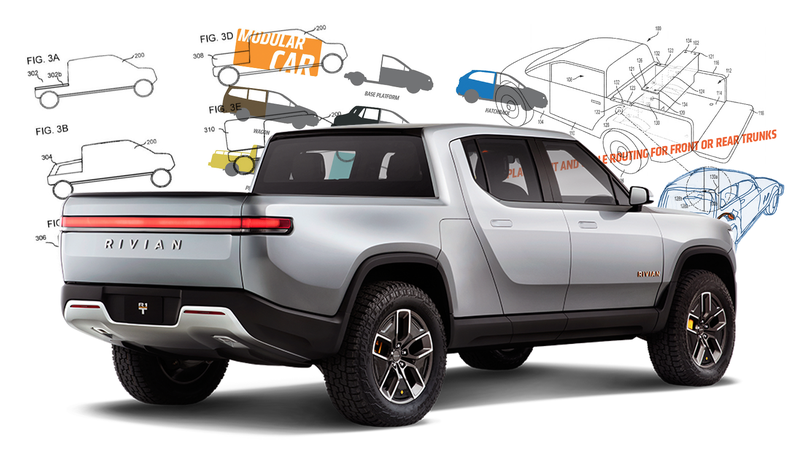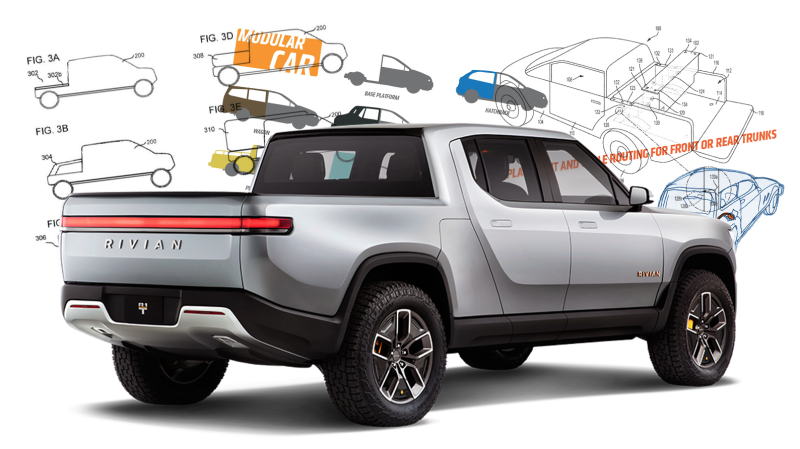
First, let me be clear that I’m not, in any legal sense, accusing anyone of anything. All I’m saying is that there’s been two recent patent filings from the electric truck-making startup Rivian that happen to be a hell of a lot like ideas from articles I’ve written in the past. They’re ideas that, I think, just make sense, so it’s very likely they came to them independently. Still, just let me have this for a little bit.
The two patents cover two very different concepts for electric vehicles: One is a sort of auxiliary battery pack to extend range, and the other is a concept for modular bodies that could be used to reconfigure an electric vehicle, especially in the context of shared cars.
In the past, I’ve published ideas that, I believe, are quite similar to both of these. Let’s go into a bit of detail.
For the first concept, the auxiliary battery one, is essentially talking about adding another, easily removable battery pack into the cargo area of the vehicle. Here’s the patent’s abstract:
“An electric vehicle system for transporting human passengers or cargo includes an electric vehicle that includes a body, a plurality of wheels, a cargo area, an electric motor for propelling the electric vehicle, and a primary battery for providing electrical power to the electric motor for propelling the electric vehicle. An auxiliary battery module is attachable to the electric vehicle for providing electrical power to the electric motor via a first electrical connector at the auxiliary battery module and a second electrical connector at the electric vehicle that mates with the first electrical connector. The auxiliary battery module can be positioned in the cargo area while supplying power to the electric motor, and can be removable and reattachable from the electric vehicle. The auxiliary battery module includes an integrated cooling system for cooling itself during operation of the electric vehicle including a conduit therein for circulating coolant.”
Advertisement
Now, to compare, back in 2017 I wrote an article talking about the possibility of something I not-so-cleverly called trunk batteries:
“Here’s what needs to happen: one (or more) of the major gas station franchises needs to partner with a hypothetical company that produces modular, rechargeable, swappable battery packs that can be placed into an electric car’s trunk, connect to the car’s charging system, and give the car a decent enough amount of range to be useful.”
Advertisement
We’re talking about the same thing, here: the ability to stick an extra battery pack into your vehicle’s cargo area to increase the effective range.

Granted, their drawing is much less cartoony and shows placement in a truck bed instead of passenger car trunks, but the concept is fundamentally the same.
Advertisement
It’s not exactly a revolutionary concept, and I’m under no illusions that similar ideas haven’t been thought of by many people, but I think it’s still worth noting.
The other concept has to do with the inherently packaging-efficient and flexible nature of building electric vehicles with a flat, integrated-battery “skateboard”-type chassis, like Rivian and Tesla use.
Such a straightforward method of construction would make the possibility of modular body sections, designed to dramatically transform the capabilities of the vehicle, very appealing. This, too, is hardly a new idea—carmakers have been playing with this concept for a long while, like this ItalDesign 1982 concept and even making it into a commercial car in a very limited way with the Nissan Pulsar:

Advertisement
What I proposed back in 2015 was a sort of chassis cab-style base car, with a body that only extended to the B-pillar, and a flat rear designed to accept a variety of add-on body modules, from hatchbacks to sedans to pickup trucks to campers and so on.
I even made a little chart with a bunch of possible options:

Advertisement
Could be fun, right?
Rivian’s patent, uncovered in this article from Forbes, describes something quite similar, and even has a familiar-looking chart:
s

Advertisement
Now, Rivian’s base design is a bit different, being a four-door double-cab, but conceptually, it’s exactly the same thing.
Of course, where I was thinking of this in terms of a person owning the base vehicle and having some sort of swap/subscription-based model for the add-on modules, Rivian is thinking of this mostly in terms of making car sharing more flexible, as they state in this patent-jargony abstract:
“Utilization of shared vehicles that are structurally and reversibly reconfigurable to suit requests for particular vehicle configurations is described. Vehicle use is monitored for plural vehicles shared among multiple users/uses. In response to a first request for a first particular configuration of a vehicle, a first vehicle is selected/provided in the first particular configuration having a predetermined first feature set, the first feature set being automatically set based on the first vehicle being placed in the first particular configuration. In response to a second use request for a second particular configuration of a vehicle different from the first particular configuration, the first vehicle is selected/provided in the second particular configuration having a predetermined second feature set, the second feature set being automatically set at the first vehicle based on the first vehicle being placed in the second particular configuration, the first feature set being different from the second feature set.”
Advertisement
That kind of hurts to read, but the pictures make sense, at least.
Rivian, of course, goes into much more detail in the patent, especially discussing the methods used to tell the base vehicle what module it’s mated to via RFID and other fun electronic crap.
Once again, I’m not accusing Rivian of anything, though I’d like to imagine that perhaps some of my articles provided inspiration. I just put the ideas out into the aether, with no attempt to protect them, so I can’t really complain no matter what. I’m just happy to see these particular ideas possibly implemented, though, as I think they both have merit and, especially in the case of the modular body one, has been a latent dream of car designers for decades.
Advertisement
Anyway, good luck Rivian, and, yes, you’re welcome.













